薄膜介电常数测试方法
介电常数稳定测量方法
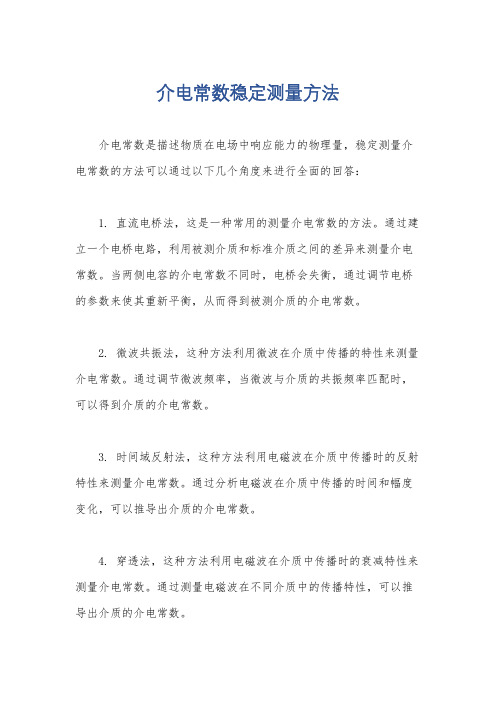
介电常数稳定测量方法
介电常数是描述物质在电场中响应能力的物理量,稳定测量介电常数的方法可以通过以下几个角度来进行全面的回答:
1. 直流电桥法,这是一种常用的测量介电常数的方法。
通过建立一个电桥电路,利用被测介质和标准介质之间的差异来测量介电常数。
当两侧电容的介电常数不同时,电桥会失衡,通过调节电桥的参数来使其重新平衡,从而得到被测介质的介电常数。
2. 微波共振法,这种方法利用微波在介质中传播的特性来测量介电常数。
通过调节微波频率,当微波与介质的共振频率匹配时,可以得到介质的介电常数。
3. 时间域反射法,这种方法利用电磁波在介质中传播时的反射特性来测量介电常数。
通过分析电磁波在介质中传播的时间和幅度变化,可以推导出介质的介电常数。
4. 穿透法,这种方法利用电磁波在介质中传播时的衰减特性来测量介电常数。
通过测量电磁波在不同介质中的传播特性,可以推导出介质的介电常数。
5. 振荡电路法,这种方法利用介质对电路振荡频率的影响来测量介电常数。
通过测量电路在不同介质中的振荡频率,可以推导出介质的介电常数。
总的来说,测量介电常数的方法有很多种,每种方法都有其适用的范围和精度。
在实际应用中,需要根据具体的情况选择合适的测量方法来进行介电常数的稳定测量。
薄膜介电测试

薄膜介电测试
薄膜介电测试是一种用于测量薄膜的介电常数和损耗因子的技术。
薄膜介电测试的目的是为了确保在电路中使用的薄膜材料具有准确、稳定的电学性能。
常用的薄膜介电测试方法有以下几种:
1.传统方法:以高频串联谐振电路的方式对薄膜样品进行测试,通过测量电路的谐振频率和品质因数来计算薄膜的介电常数和损耗因子。
2.微波共振法:使用微波频率的信号对薄膜进行测试,测量信号的反射、透射和相移等参数,计算薄膜的介电常数和损耗因子。
3.椭偏振法:通过测量薄膜对光线的偏振影响来计算薄膜的介电常数和损耗因子,适用于透明薄膜的测试。
薄膜介电测试的结果可以帮助制造商优化材料配方、改进生产工艺,提高产品性能和品质。
bopet的介电常数

标题:BOPET的介电常数及其应用引言:BOPET(双向拉伸聚酯薄膜)是一种广泛应用于包装、电子、光学等领域的高性能聚酯薄膜。
作为一种具有优异物理和化学性质的材料,BOPET的介电常数在其应用中起着举足轻重的作用。
本文将详细介绍BOPET的介电常数及其相关知识,并探讨其在实际应用中的价值。
一、什么是介电常数1. 介电常数的定义介电常数(Dielectric constant)是衡量物质对电场的响应能力的物理量。
它描述了物质在电场作用下的极化程度,通常用ε或εr表示。
2. 介电常数的影响因素介电常数的大小与物质的分子结构、摩尔极化率以及分子间相互作用力等密切相关。
较高的介电常数意味着物质更容易被电场极化,从而导致更强的电场相互作用。
二、BOPET的介电常数特点1. BOPET的组成和制备工艺BOPET由聚对苯二甲酸乙二醇酯(PET)通过拉伸等工艺制备而成。
其聚合度高、分子链长,使得BOPET具有良好的物理性能和化学稳定性。
2. BOPET的介电常数范围BOPET的介电常数通常在2.9至3.4之间,介电常数随频率的变化相对较小。
这种低介电常数的特点使得BOPET在电子器件、光学材料等领域具有广泛应用前景。
三、BOPET介电常数的应用1. 电子领域由于BOPET具有较低的介电常数和良好的绝缘性能,它被广泛应用于电子元件的制造中。
如BOPET薄膜可用于电容器、电感元件等的绝缘层,提高元件的工作效率和稳定性。
2. 光学领域BOPET具有良好的透明性和光学性能,使其成为光学薄膜的理想候选材料。
其低介电常数使得BOPET薄膜在光学设备、显示器件等领域具有广泛应用,如液晶显示屏、太阳能电池等。
3. 包装领域BOPET薄膜由于具有高强度、优良的热封性能和化学稳定性,成为食品、药品等行业中广泛使用的包装材料。
其低介电常数使得BOPET包装薄膜在电子产品、精密仪器等领域中可以避免静电干扰和电场相互作用。
4. 汽车行业BOPET薄膜还可应用于汽车行业,用于制造电池隔膜、电子标签、照明等方面。
聚合物介电常数和介电损耗的测定
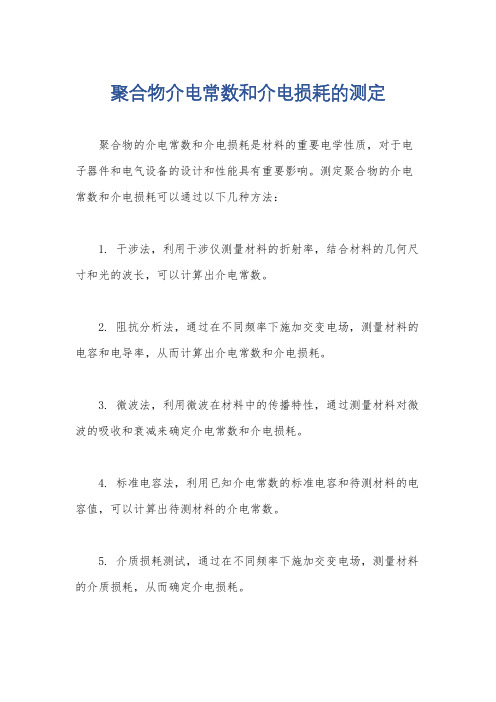
聚合物介电常数和介电损耗的测定
聚合物的介电常数和介电损耗是材料的重要电学性质,对于电子器件和电气设备的设计和性能具有重要影响。
测定聚合物的介电常数和介电损耗可以通过以下几种方法:
1. 干涉法,利用干涉仪测量材料的折射率,结合材料的几何尺寸和光的波长,可以计算出介电常数。
2. 阻抗分析法,通过在不同频率下施加交变电场,测量材料的电容和电导率,从而计算出介电常数和介电损耗。
3. 微波法,利用微波在材料中的传播特性,通过测量材料对微波的吸收和衰减来确定介电常数和介电损耗。
4. 标准电容法,利用已知介电常数的标准电容和待测材料的电容值,可以计算出待测材料的介电常数。
5. 介质损耗测试,通过在不同频率下施加交变电场,测量材料的介质损耗,从而确定介电损耗。
需要注意的是,测定介电常数和介电损耗时要考虑温度、湿度、频率等因素对测量结果的影响,并且选择合适的测量方法和仪器以
确保测量的准确性和可靠性。
同时,针对不同类型的聚合物材料可
能需要采用不同的测量方法,以获得更精确的结果。
多孔薄膜介电常数的测试方法研究
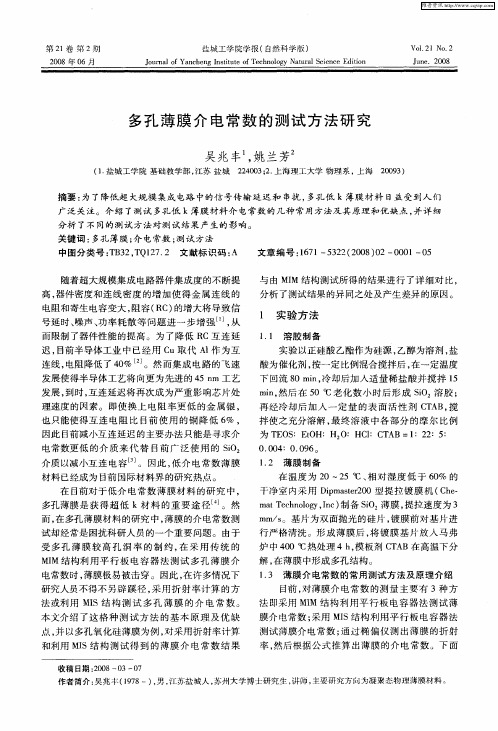
1 2 薄膜 制 备 . 在 温度 为 2 O~2 c、 对湿 度 低 于 6 % 的 5c 相 0 干净 室 内采 用 D p at 2 0型提 拉 镀 膜 机 ( h . im s r0 e Ce m t eh ooy Ic 制备 SO 薄 膜 , a Tcnl , ) g n i2 提拉 速度 为 3 m / 。基 片为双 面抛 光 的硅 片 , 膜 前对 基 片进 ms 镀
摘 要 : 了降低超 大规 模 集成 电路 中的信 号 传输 延ቤተ መጻሕፍቲ ባይዱ迟 和 串扰 , 为 多孔 低 k薄 膜材 料 日益 受到 人 们
广泛 关注 。介 绍 了测 试 多孔低 k薄膜 材料介 电常数 的几 种 常 用方法及 其原 理和优 缺 点 , 并详 细
分析 了不 同的测 试 方法对 测 试结果 产 生的影 响 。
维普资讯
第 2 卷 第 2期 1
20 0 8年 0 6月
盐 城 工 学 院学 报 ( 自然 科 学 版 )
J u n lo n h n n t u e o e h oo y N t r l c e c d t n o r a fYa c e g I s t t fT c n lg a u a in e E i o i S i
理 速度 的 因素 。即 使 换 上 电 阻 率更 低 的金 属 银 ,
再 经冷却 后 加 入 一 定 量 的表 面活 性 剂 C A 搅 T B, 拌使 之 充分 溶解 , 终 溶 液 中各 部 分 的摩 尔 比例 最
为 T O :EO E S t H:H 0 2 :HC:C AB=1 2 5 I T :2 : :
Vo . No. 121 2
J n .2 0 ue 08
多 孑 薄 膜 介 电 常 数 的 测 试 方 法 研 究 L
使用 LCR 表和阻抗分析仪测量介电常数和导磁率的决方案
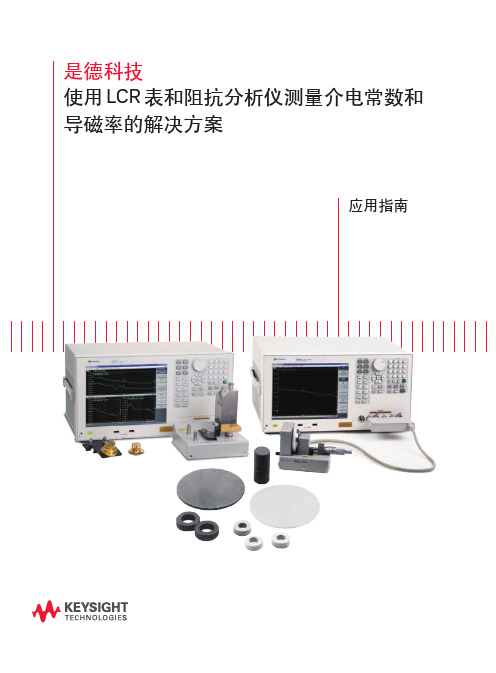
– 频率范围宽: 从 20 Hz 到 1 GHz – 测量精度高 – 测量的准备工作非常简单 (材料制
备、测量设置)
本指南首先在第 2 部分介绍介电常数的 测量方法、测量系统和解决方案,而 后在第 3 部分介绍导磁率的测量方法、 系统和解决方案,最后在附录中说明 适用于液体的电阻率测量系统和导磁 率测量系统。
1. 引言
近年来,电子设备技术获得了蓬勃发 展,而这也使得电子元器件的材料特征 成为决定电路特性的关键因素。例如, 在制造数字 (媒体) 设备中常用的高容量 多层片式陶瓷电容器 (MLCC) 时,必须 要采用高 κ 值 (介电常数) 材料。此外, 在选择材料之前还必须执行各项电气性 能验证,例如频率和温度响应。
3.2. 电感测量法 ......................................................................................................... 17
3.3. 导磁率测量系统 .................................................................................................. 18
表 1. 介电常数和导磁率参数的测量技术和测量方法
测量参数
测量技术
阻抗分析
介电常数
导磁率
阻抗分析 网络分析
测量方法 平行板法 S 参数 腔体 真空 电感 反射波 S 参数 腔体
04 | Keysight | 使用 LCR 表和阻抗分析仪测量介电常数和导磁率的解决方案-应用指南
2. 介电常数测试
2.1. 介电常数的定义
3.4. 使用 16454A 磁性材料测试夹具的测量系统 ..................................................... 18
介电常数检测
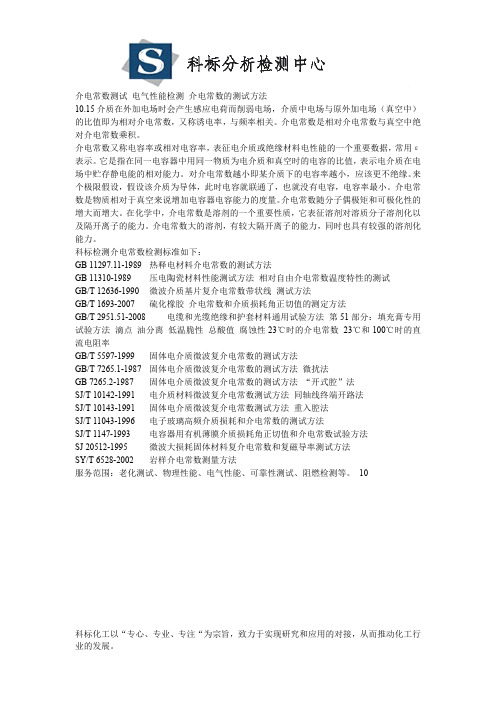
介电常数测试电气性能检测介电常数的测试方法10.15介质在外加电场时会产生感应电荷而削弱电场,介质中电场与原外加电场(真空中)的比值即为相对介电常数,又称诱电率,与频率相关。
介电常数是相对介电常数与真空中绝对介电常数乘积。
介电常数又称电容率或相对电容率,表征电介质或绝缘材料电性能的一个重要数据,常用ε表示。
它是指在同一电容器中用同一物质为电介质和真空时的电容的比值,表示电介质在电场中贮存静电能的相对能力。
对介电常数越小即某介质下的电容率越小,应该更不绝缘。
来个极限假设,假设该介质为导体,此时电容就联通了,也就没有电容,电容率最小。
介电常数是物质相对于真空来说增加电容器电容能力的度量。
介电常数随分子偶极矩和可极化性的增大而增大。
在化学中,介电常数是溶剂的一个重要性质,它表征溶剂对溶质分子溶剂化以及隔开离子的能力。
介电常数大的溶剂,有较大隔开离子的能力,同时也具有较强的溶剂化能力。
科标检测介电常数检测标准如下:GB11297.11-1989热释电材料介电常数的测试方法GB11310-1989压电陶瓷材料性能测试方法相对自由介电常数温度特性的测试GB/T12636-1990微波介质基片复介电常数带状线测试方法GB/T1693-2007硫化橡胶介电常数和介质损耗角正切值的测定方法GB/T2951.51-2008电缆和光缆绝缘和护套材料通用试验方法第51部分:填充膏专用试验方法滴点油分离低温脆性总酸值腐蚀性23℃时的介电常数23℃和100℃时的直流电阻率GB/T5597-1999固体电介质微波复介电常数的测试方法GB/T7265.1-1987固体电介质微波复介电常数的测试方法微扰法GB7265.2-1987固体电介质微波复介电常数的测试方法“开式腔”法SJ/T10142-1991电介质材料微波复介电常数测试方法同轴线终端开路法SJ/T10143-1991固体电介质微波复介电常数测试方法重入腔法SJ/T11043-1996电子玻璃高频介质损耗和介电常数的测试方法SJ/T1147-1993电容器用有机薄膜介质损耗角正切值和介电常数试验方法SJ20512-1995微波大损耗固体材料复介电常数和复磁导率测试方法SY/T6528-2002岩样介电常数测量方法服务范围:老化测试、物理性能、电气性能、可靠性测试、阻燃检测等。
使用 LCR 表和阻抗分析仪测量介电常数和导磁率的决方案

2.
介电常数测试 ........................................................................................................ 4
2.1. 介电常数的定义 .................................................................................................... 4
+
电场
06 | Keysight | 使用 LCR 表和阻抗分析仪测量介电常数和导磁率的解决方案-应用指南
接触电极法:
这种方法通过测量与 MUT 直接接触的电 极的电容来推导出介电常数 (图 4)。介电 常数和损耗角正切通过以下公式 计算:
被保护电极 d
保护电极 g
Cp: MUT 的等效平行电容 [F] D: 耗散系数 (测量值) tm: MUT 的平均厚度 [m] A: 被保护电极的表面积 [m2] d: 被保护电极的直径 [m] ε0: 自由空间的介\电常数 =
边缘 (杂散) 电容
保护电极
-
-
使用保护电极,可以消除边缘电容所导 致的测量误差。保护电极会吸收边缘的 电场,所以在电极之间测得的电容只是 由流经介电材料的电流形成,这样便可以 获得准确的测量结果。当结合使用主电极 和保护电极时,主电极称为被保护电极 (guarded electrode)。
+
电场
图 3. 保护电极的效应
3.2. 电感测量法 ......................................................................................................... 17
塑料薄膜抗静电剂处理技术及测试方法
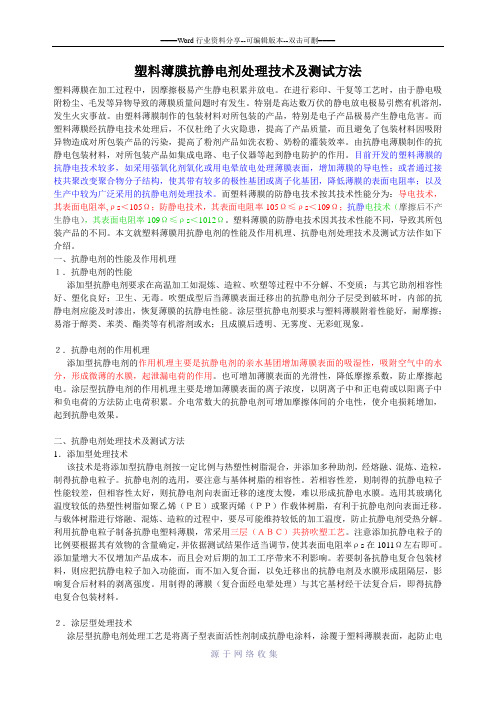
塑料薄膜抗静电剂处理技术及测试方法塑料薄膜在加工过程中,因摩擦极易产生静电积累并放电。
在进行彩印、干复等工艺时,由于静电吸附粉尘、毛发等异物导致的薄膜质量问题时有发生。
特别是高达数万伏的静电放电极易引燃有机溶剂,发生火灾事故。
由塑料薄膜制作的包装材料对所包装的产品,特别是电子产品极易产生静电危害。
而塑料薄膜经抗静电技术处理后,不仅杜绝了火灾隐患,提高了产品质量,而且避免了包装材料因吸附异物造成对所包装产品的污染,提高了粉剂产品如洗衣粉、奶粉的灌装效率。
由抗静电薄膜制作的抗静电包装材料,对所包装产品如集成电路、电子仪器等起到静电防护的作用。
目前开发的塑料薄膜的抗静电技术较多,如采用强氧化剂氧化或用电晕放电处理薄膜表面,增加薄膜的导电性;或者通过接枝共聚改变聚合物分子结构,使其带有较多的极性基团或离子化基团,降低薄膜的表面电阻率;以及生产中较为广泛采用的抗静电剂处理技术。
而塑料薄膜的防静电技术按其技术性能分为:导电技术,其表面电阻率,ρs<105Ω;防静电技术,其表面电阻率105Ω≤ρs<109Ω;抗静电技术(摩擦后不产生静电),其表面电阻率109Ω≤ρs<1012Ω。
塑料薄膜的防静电技术因其技术性能不同,导致其所包装产品的不同。
本文就塑料薄膜用抗静电剂的性能及作用机理、抗静电剂处理技术及测试方法作如下介绍。
一、抗静电剂的性能及作用机理1.抗静电剂的性能添加型抗静电剂要求在高温加工如混炼、造粒、吹塑等过程中不分解、不变质;与其它助剂相容性好、塑化良好;卫生、无毒。
吹塑成型后当薄膜表面迁移出的抗静电剂分子层受到破坏时,内部的抗静电剂应能及时渗出,恢复薄膜的抗静电性能。
涂层型抗静电剂要求与塑料薄膜附着性能好,耐摩擦;易溶于醇类、苯类、酯类等有机溶剂或水;且成膜后透明、无雾度、无彩虹现象。
2.抗静电剂的作用机理添加型抗静电剂的作用机理主要是抗静电剂的亲水基团增加薄膜表面的吸湿性,吸附空气中的水分,形成微薄的水膜,起泄漏电荷的作用。
介电常数常用测量方法综述
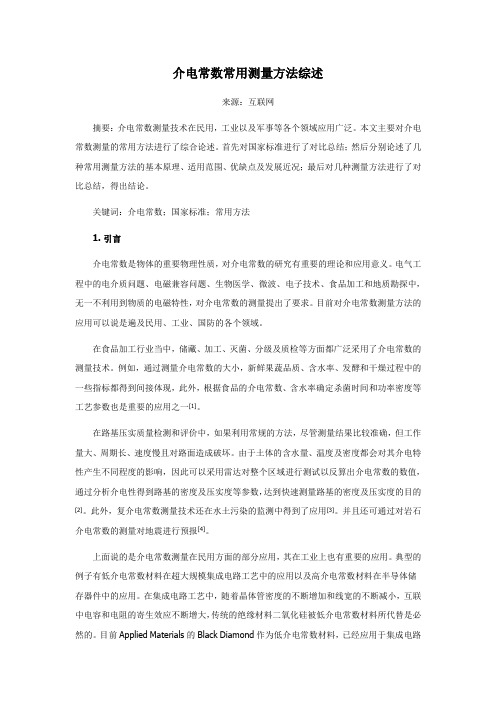
介电常数常用测量方法综述来源:互联网摘要:介电常数测量技术在民用,工业以及军事等各个领域应用广泛。
本文主要对介电常数测量的常用方法进行了综合论述。
首先对国家标准进行了对比总结;然后分别论述了几种常用测量方法的基本原理、适用范围、优缺点及发展近况;最后对几种测量方法进行了对比总结,得出结论。
关键词:介电常数;国家标准;常用方法1. 引言介电常数是物体的重要物理性质,对介电常数的研究有重要的理论和应用意义。
电气工程中的电介质问题、电磁兼容问题、生物医学、微波、电子技术、食品加工和地质勘探中,无一不利用到物质的电磁特性,对介电常数的测量提出了要求。
目前对介电常数测量方法的应用可以说是遍及民用、工业、国防的各个领域。
在食品加工行业当中,储藏、加工、灭菌、分级及质检等方面都广泛采用了介电常数的测量技术。
例如,通过测量介电常数的大小,新鲜果蔬品质、含水率、发酵和干燥过程中的一些指标都得到间接体现,此外,根据食品的介电常数、含水率确定杀菌时间和功率密度等工艺参数也是重要的应用之一[1]。
在路基压实质量检测和评价中,如果利用常规的方法,尽管测量结果比较准确,但工作量大、周期长、速度慢且对路面造成破坏。
由于土体的含水量、温度及密度都会对其介电特性产生不同程度的影响,因此可以采用雷达对整个区域进行测试以反算出介电常数的数值,通过分析介电性得到路基的密度及压实度等参数,达到快速测量路基的密度及压实度的目的[2]。
此外,复介电常数测量技术还在水土污染的监测中得到了应用[3]。
并且还可通过对岩石介电常数的测量对地震进行预报[4]。
上面说的是介电常数测量在民用方面的部分应用,其在工业上也有重要的应用。
典型的例子有低介电常数材料在超大规模集成电路工艺中的应用以及高介电常数材料在半导体储存器件中的应用。
在集成电路工艺中,随着晶体管密度的不断增加和线宽的不断减小,互联中电容和电阻的寄生效应不断增大,传统的绝缘材料二氧化硅被低介电常数材料所代替是必然的。
薄膜介电常数测试方法

薄膜介电常数测试方法好,咱们聊聊薄膜介电常数测试的方法。
这可不是个高深莫测的话题,实际上,它就像一道家常菜,简单易做,只要掌握了几招,保证你可以做得风生水起。
薄膜可不是咱们平时吃的薄饼,它指的是那些在各种电子器件中使用的超薄材料。
想象一下,一个薄薄的塑料袋,里面可能藏着很多秘密,这些秘密就体现在它的介电常数上。
介电常数说白了就是材料在电场中的表现,它决定了材料如何存储和传递电能。
说到这,大家可能会想:“这玩意儿干嘛用的?”简单来说,了解这些数值能帮助工程师们设计更好的电路板、传感器,还有那些花里胡哨的手机。
咱们先聊聊最常见的测试方法,叫做电容法。
想象一下,你正在超市购物,眼前是满满一架的零食。
电容法就像是挑选那些好吃的薯片,方法简单又直接。
你只需要准备一块薄膜,把它夹在两个电极之间,然后施加一个电压。
嘿,这时候就能测出它的电容值。
你问怎么测的?这可不是随便的事儿,得用精密的仪器,保证测试的准确性。
就可以用公式算出介电常数。
要是算出来的值不符合预期,那就要认真检查一下,看看电极是不是接触不良,或者薄膜是不是被损坏了。
就像买薯片时,要确保袋子没有破,里面的薯片才不会变成碎屑。
还有一种方法叫阻抗谱法。
听起来是不是有点高大上?别担心,其实就像一场音乐会,每个乐器都有自己的声音。
阻抗谱法的原理就是测量不同频率下的阻抗,看看薄膜的表现如何。
这就像你在不同场合下的状态,可能在派对上你是个社交达人,但在图书馆就变得安静得像小猫咪。
通过分析这些数据,咱们可以得到介电常数在不同频率下的变化情况。
这种方法的好处是能够更细致地了解材料的特性,就像是在观察一颗璀璨的宝石,细细品味其中的光彩。
测试的时候要注意环境条件。
温度、湿度,甚至是空气的质量都能影响测试结果。
就像你在外面吃饭,天冷了你会点热汤,天热了又想来点冰饮。
保证测试环境的稳定性非常重要,毕竟你可不想因为外界因素而影响到你的测试结果。
一般来说,实验室会设定好标准的温度和湿度,像是给薄膜穿上了一件合身的衣服,让它在最舒适的环境中展现出最佳状态。
薄膜介电常数 测试

薄膜介电常数测试
薄膜介电常数测试是一种对材料介电性能的测量方法。
薄膜介电常数是指薄膜中电场强度与电场引起的电位变化之比。
这个比值越大,说明薄膜对电场的响应能力越强,介电常数也就越大。
薄膜介电常数测试可以通过多种手段进行,如电容法、阻抗法、光学法等。
其中,电容法是比较常见的一种测试方法。
该方法是利用电容器的性质来测试薄膜的介电常数。
将薄膜作为电容器中的介质,通过测量电容器的电容值和电源频率,计算出薄膜的介电常数。
此外,阻抗法可以通过测量薄膜的电阻和电感来计算出薄膜的介电常数,而光学法则是通过测量材料在不同光谱范围内的吸收系数和折射率来计算
薄膜的介电常数。
薄膜介电常数测试是一种非常重要的测试方法,可以用于评估材料在电场下的性能,并为材料的应用提供依据。
该测试方法广泛应用于电子、光电、通信、航空航天等领域。
- 1 -。
胶膜 介电常数 测标准试

胶膜介电常数测标准试
胶膜的介电常数测试是评估其电性能的重要手段。
在标准测试条件下,这一参数能够反映胶膜的电学性质,对于理解其在各种应用场景中的表现具有重要意义。
在进行介电常数测试时,首先需要确保测试环境的稳定性和一致性。
这包括温度、湿度、空气成分等环境因素的严格控制。
这是因为这些因素可能对胶膜的介电性能产生影响,进而影响测试结果的准确性。
其次,选择合适的测试方法也是关键。
通常,我们会使用平行板电容法或传输线法来测量胶膜的介电常数。
这些方法各有优缺点,需要根据具体情况进行选择。
同时,为了保证测试结果的准确性,还需要对测试设备进行定期校准和维护。
在测试过程中,需要严格按照标准操作流程进行。
这包括样品的准备、测试环境的设置、数据的记录和处理等。
任何环节的失误都可能影响测试结果的准确性,因此需要格外注意。
最后,对于测试结果的分析和解读也是非常重要的。
通过对比不同胶膜的介电常数,我们可以了解它们在电学性能上的差异,进而指导材料的选择和应用。
同时,也可以通过测试结果对生产工艺进行优化,提高产品质量。
综上所述,胶膜的介电常数测试是一项复杂而重要的工作。
只有严格遵守标准操作流程,才能获得准确可靠的测试结果,为胶膜的应用和发展提供有力支持。
氧化物薄膜电学测试
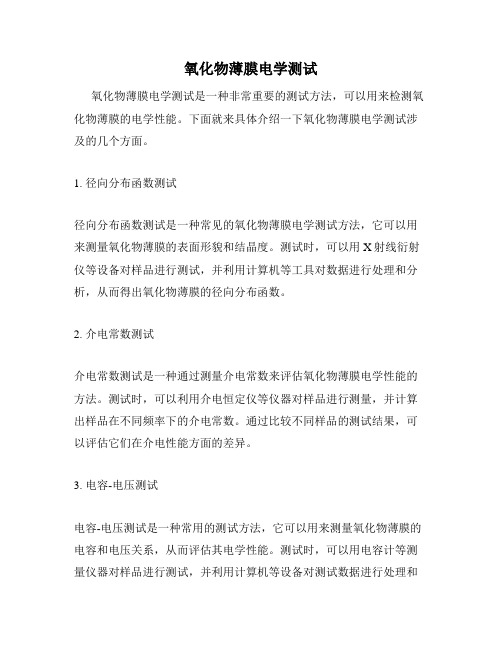
氧化物薄膜电学测试
氧化物薄膜电学测试是一种非常重要的测试方法,可以用来检测氧化物薄膜的电学性能。
下面就来具体介绍一下氧化物薄膜电学测试涉及的几个方面。
1. 径向分布函数测试
径向分布函数测试是一种常见的氧化物薄膜电学测试方法,它可以用来测量氧化物薄膜的表面形貌和结晶度。
测试时,可以用X射线衍射仪等设备对样品进行测试,并利用计算机等工具对数据进行处理和分析,从而得出氧化物薄膜的径向分布函数。
2. 介电常数测试
介电常数测试是一种通过测量介电常数来评估氧化物薄膜电学性能的方法。
测试时,可以利用介电恒定仪等仪器对样品进行测量,并计算出样品在不同频率下的介电常数。
通过比较不同样品的测试结果,可以评估它们在介电性能方面的差异。
3. 电容-电压测试
电容-电压测试是一种常用的测试方法,它可以用来测量氧化物薄膜的电容和电压关系,从而评估其电学性能。
测试时,可以用电容计等测量仪器对样品进行测试,并利用计算机等设备对测试数据进行处理和
分析,得出电容-电压曲线和相关的参数。
4. 氧化物薄膜形貌测试
氧化物薄膜形貌测试是一种能够对氧化物薄膜表面形貌进行分析和评估的方法。
测试时,可以利用原子力显微镜等高分辨率显微镜对样品表面进行测试,从而得出氧化物薄膜的表面形貌和相关的参数。
这些参数可以用来衡量氧化物薄膜的结晶度、粗糙度等特征,进而评估其电学性能。
综上所述,氧化物薄膜电学测试涉及多个方面,其中包括径向分布函数测试、介电常数测试、电容-电压测试以及氧化物薄膜形貌测试等方法。
这些测试方法可以相互补充,为评估氧化物薄膜的电学性能提供多方面的指导。
薄膜达因值测量方法

薄膜达因值测量方法
薄膜达因值也称为介电常数,是指材料的电容率与真空电容率之比。
以下是一种常见的薄膜达因值测量方法:
1. 准备样品和测试仪器:首先需要准备待测的薄膜样品和测试仪器,如LCR表、高频信号源等。
2. 确定测试频率:根据实际需求,选择合适的测试频率。
一般情况下,测试频率在1 kHz到1 MHz之间较为常见。
3. 连接测试仪器:将测试仪器与待测样品连接好,确保连接正常稳定,并对测试仪器进行校准和调试。
4. 开始测试:在测试仪器上设置好测试条件,启动测试过程。
此时,测试仪器会向样品中输入高频信号,然后测量样品的电容值和电阻值。
5. 计算达因值:通过测量得到的电容值和电阻值,可以计算出样品的达因值。
一般情况下,达因值可以通过电容值和电阻值之比来计算得到。
需要注意的是,在进行薄膜达因值测量时,应该避免使用金属或其他导电性材料与样品接触,以免干扰测量结果。
此外,应该保证测试环境的稳定和一致性,以确保测量结果的准确性和可靠性。
晶圆表面的薄膜及其量测

晶圆表面的薄膜及其量测
晶圆表面通常会涂覆上薄膜,这些薄膜的主要用途是改变晶圆的物理特性或应用于电子器件的制造中。
常见的薄膜包括:
1. 导电薄膜:如金属薄膜(铝、铜等),用于制造电极或连接线路。
2. 绝缘薄膜:如二氧化硅、氮化硅等,用于制造电子元件的绝缘层。
3. 介电薄膜:如氮化铝、氮化硼等,用于调节晶圆上的电场分布或电介质层。
4. 磁性薄膜:如铁薄膜、钴薄膜等,用于制造磁性存储器件或磁传感器。
5. 光学薄膜:如氧化锌、二氧化锡等,用于制造光学器件或薄膜太阳能电池。
为了确保薄膜质量和性能,需要进行薄膜的量测。
常见的薄膜量测方法包括:
1. 厚度测量:利用激光干涉法、X射线衍射法或原子力显微镜等技术,测量薄膜的厚度。
2. 晶体结构分析:通过X射线衍射或电子衍射等技术,分析
薄膜的晶体结构、晶格常数等信息。
3. 表面形貌观测:利用扫描电子显微镜(SEM)、原子力显
微镜(AFM)等技术,观察薄膜表面的形貌和光滑度。
4. 光学性质测试:通过紫外-可见光谱仪、激光扫描共聚焦显
微镜等设备,测量薄膜的透过率、反射率、折射率等光学性质。
5. 电学性质测试:使用电子测试仪器(如四探针仪、霍尔效应
测量仪等),测量薄膜的电阻率、介电常数、磁场敏感度等电学性质。
这些量测方法可以帮助研究人员或制造商了解薄膜材料的性质与性能,以进一步优化晶圆表面涂覆的薄膜。
多孔薄膜介电常数的测试方法研究
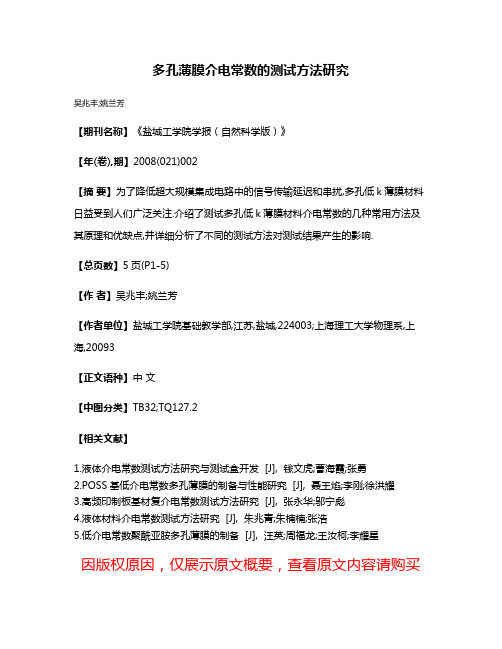
多孔薄膜介电常数的测试方法研究
吴兆丰;姚兰芳
【期刊名称】《盐城工学院学报(自然科学版)》
【年(卷),期】2008(021)002
【摘要】为了降低超大规模集成电路中的信号传输延迟和串扰,多孔低k薄膜材料日益受到人们广泛关注.介绍了测试多孔低k薄膜材料介电常数的几种常用方法及其原理和优缺点,并详细分析了不同的测试方法对测试结果产生的影响.
【总页数】5页(P1-5)
【作者】吴兆丰;姚兰芳
【作者单位】盐城工学院基础教学部,江苏,盐城,224003;上海理工大学物理系,上海,20093
【正文语种】中文
【中图分类】TB32;TQ127.2
【相关文献】
1.液体介电常数测试方法研究与测试盒开发 [J], 钱文虎;曹海霞;张勇
2.POSS基低介电常数多孔薄膜的制备与性能研究 [J], 聂王焰;李刚;徐洪耀
3.高频印制板基材复介电常数测试方法研究 [J], 张永华;邬宁彪
4.液体材料介电常数测试方法研究 [J], 朱兆青;朱楠楠;张浩
5.低介电常数聚酰亚胺多孔薄膜的制备 [J], 汪英;周福龙;王汝柯;李耀星
因版权原因,仅展示原文概要,查看原文内容请购买。
- 1、下载文档前请自行甄别文档内容的完整性,平台不提供额外的编辑、内容补充、找答案等附加服务。
- 2、"仅部分预览"的文档,不可在线预览部分如存在完整性等问题,可反馈申请退款(可完整预览的文档不适用该条件!)。
- 3、如文档侵犯您的权益,请联系客服反馈,我们会尽快为您处理(人工客服工作时间:9:00-18:30)。
with Ј close to 102. The results provide another piece of evidence for an extrinsic, Maxwell-Wagner type,
origin of the colossal dielectric response of the bulk CCTO material, connected with electrical inhomrial.
DOI: 10.1103/PhysRevB.70.144101
PACS number(s): 77.84.Ϫs, 77.22.Ch, 77.55.ϩf,
I. INTRODUCTION
There exists considerable interest in the dielectric behavior of the compound CaCu3Ti4O12 (CCTO). This material in ceramic and single-crystalline forms shows colossal dielectric response with relative permittivity Ј up to 105 at room temperature, which is practically frequency independent between dc and 106 Hz for the temperature range between 100 and 600 K. The dielectric permittivity abruptly drops down to a value ϳ100 upon lowering the temperature below 100 K. The value Ј ϳ 100 is also seen at frequencies of a few times 106 Hz and higher.1,2 The dielectric response behavior of the material is characteristic of Debye-like relaxation with a single relaxation time.
PHYSICAL REVIEW B 70, 144101 (2004)
Evidence for power-law frequency dependence of intrinsic dielectric response in the CaCu3Ti4O12
Alexander Tselev,* Charles M. Brooks, and Steven M. Anlage
In this article we report that the dielectric response of thin epitaxial CCTO films is strongly dominated by a power law, and they behave as semiconductors with hopping conduction. Experiments on oxygen annealing suggest that the films with lower oxygen content are intrinsically more conducting.
Center for Superconductivity Research, Department of Physics, University of Maryland, College Park, Maryland 20742-4111, USA
Haimei Zheng and Lourdes Salamanca-Riba Department of Materials and Nuclear Engineering, University of Maryland, College Park, Maryland 20742-2115, USA
to the Debye-like response of the bulk material. The film conductivity decreases with annealing in oxygen, and
it suggests that oxygen deficit is a cause of the relatively high film conductivity. With increase of the oxygen
arising due to some “extrinsic” factors such as lattice defects3 or Schottky barriers at electrode-sample interfaces.4 Structural1 and spectroscopic2,5–7 investigations of ceramic and single crystal samples along with first principles calculations8 suggest an extrinsic, Maxwell-Wagner-type, origin for the dielectric response. Subramanian et al.1 pointed out that nonconducting barrier layers, possibly twin boundaries, separating conducting domains could give rise to the colossal dielectric response of the material through a barrier-layer capacitance mechanism. Similar ideas were expressed also in Ref. 8. Based on impedance spectroscopy data, Sinclair et al.9 later suggested that CCTO ceramics are a single-step internal barrier-layer capacitor where insulating grain boundaries separate semiconducting grains.
content, the room temperature frequency response of the CCTO thin films changes from the response indicat-
ing the presence of some relatively low conducting capacitive layers to purely power law, and then toward a
(Received 17 November 2003; revised manuscript received 17 May 2004; published 4 October 2004)
We investigated the dielectric response of CaCu3Ti4O12 (CCTO) thin films grown epitaxially on LaAlO3 (001) substrates by pulsed laser deposition. The dielectric response of the films was found to be strongly dominated by a power law in frequency, typical of materials with localized hopping charge carriers, in contrast
The most conducting films show the presence of relatively
low conducting capacitive layers in their morphology and
significantly larger dielectric constants at low frequencies.
